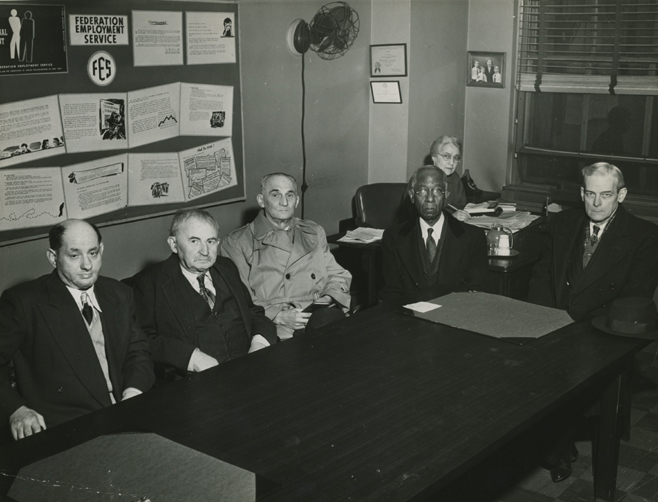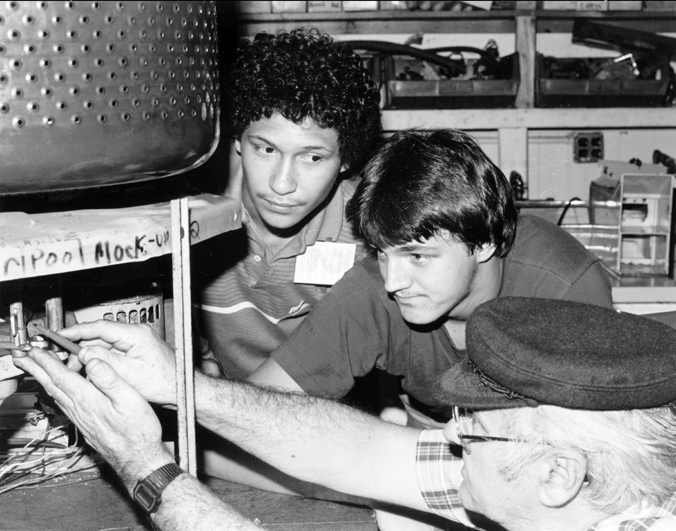1920 - 1929
Jack Nadel* (Executive Director of the 92nd St. YMHA), Samuel Leff, and A.W. Rosenthal head a committee to study the state of Jewish vocational services in New York City. Agencies providing such services at that time included:
• Brooklyn Federation Employment Service
• Emanuel Federated Employment Service
• Fellowship House
• Hebrew Orphan Asylum
• Jewish Board of Guardians
• Jewish Social Service Association (associated with the N.Y. State Employment Service)
• Young Men's Hebrew Association
• Young Women's Hebrew Association
*Jack Nadel was a founding Board member of FEGS and served for more than 45 years.
1926
On October 31st, at the convention of the Metropolitan League of Jewish Community Associations, Mr. Nadel presents the recommendations of the study, which call for the creation of a "central employment and vocational guidance bureau."
1927
The Jewish Welfare Board publishes Mr. Nadel's presentation in its March, 1927 quarterly publication, The Jewish Center. Click here to read Mr. Nadel's article.
1929
The Federation for the Support of Jewish Philanthropic Societies of New York City holds a December 3rd "Conference on Employment Problems Affecting Jews." In response to the Stock Market crash and the realization by the separate Jewish social service agencies that their individual efforts were not adequate to face the deep unemployment and the mounting discrimination against Jews in the workplace, the "Committee Sponsoring Centralization" was formed, under the chairmanship of Frederick William Greenfield.
1934
The By-Laws and Constitution of the new agency were approved.
September 17
Federation Employment Service opens its doors at 1107 Broadway in three rooms donated by Mrs. Arthur D. Schulte, one of the founding members. Six social service agencies--all members of the Federation of Jewish Philanthropies--merge their individual vocational services. The original mission is to aid young Jewish men and women prepare for and find employment and to reduce discrimination in employment. The six original agencies were: Brooklyn Federation Employment Service; Emanuel Federated Employment Service; Fellowship House; Hebrew Orphan Asylum; Jewish Board of Guardians; and the Young Men's Hebrew Association. (In 1937, the Jewish Social Service Association, previously associated with the N.Y. State Employment Service, joined the new agency, followed in 1938 by the employment department of the Young Women's Hebrew Association.)
1941
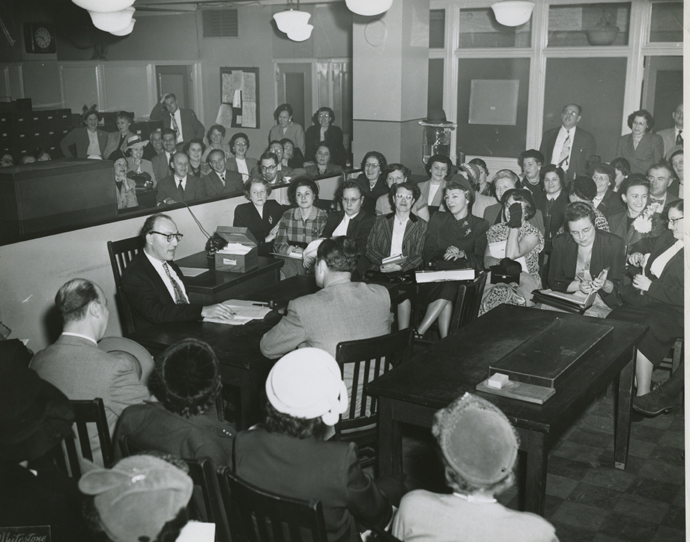
FES publishes Trade Unions in New York City - compiling information on labor apprenticeship programs, union membership requirements, and employment practices in the New York area.
Group guidance programs begun with B'nai B'rith, working with Jewish community centers, schools and synagogues. This leads to the Guidance for Victory program,
1942
Roland Baxt is appointed Executive Director. He will serve in this post for the next 35 years.
1943
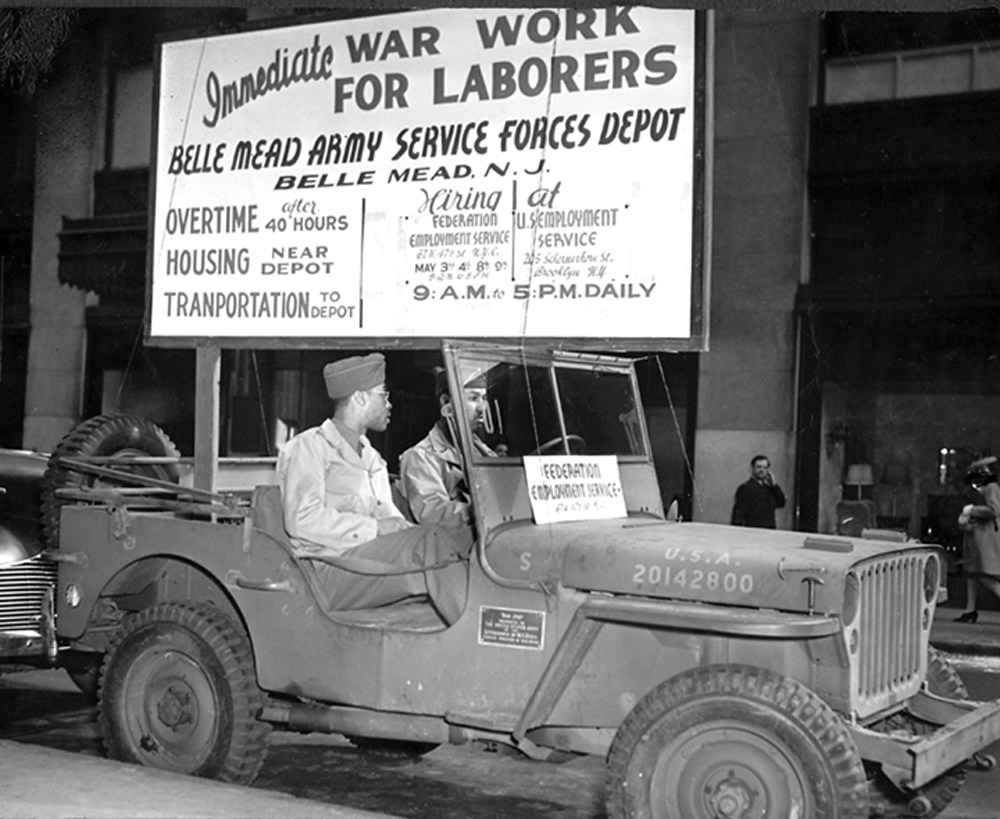
Aids in the war effort by recruiting, principally from the Jewish community, manpower for shipyards, arsenals, and aviation.
1945
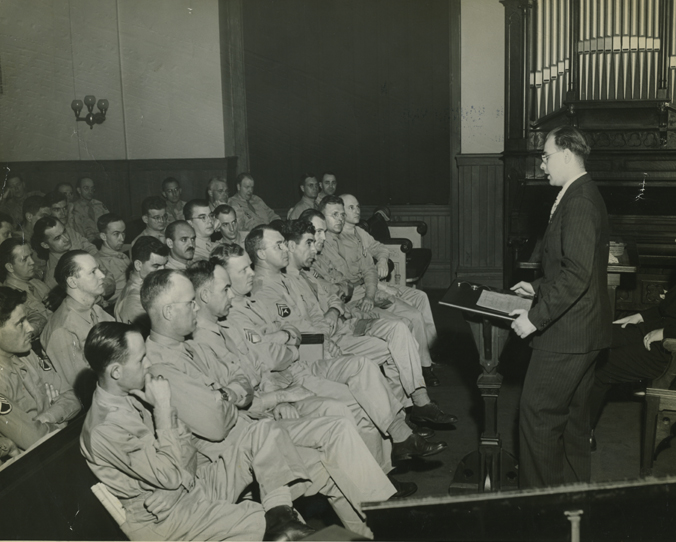
Establishes Veterans Unit to deal with readjustment problems for soldiers.
Yank, the Army weekly newspaper, distributes an FES survey of services available for discharged veterans.
1946
Citation for "Meritorious Service" from the Second Service Command of the Army Service Forces in recognition of the agency's contribution to the war effort.
Contract with the Veterans Administration to help veterans find employment or learn a trade.
1948
Launches a large-scale campaign with the slogan: "Experience, Loyalty, Skill, Come with Age" to promote job opportunities for middle-aged and older workers. The campaign receives national media attention and becomes a catalyst for legislation in New York State, and eventually by the Federal government, to outlaw age discrimination.
U.S. Employment Service asks FES to prepare a manual of procedures for working with the aged.
1950
In cooperation with the Jewish Board of Guardians, FEGS develops a special job finding program for prison inmates awaiting parole.
1951
Special program for women re-entering the job market commences.
Publishes A Guide to Educational and Vocational Training in the Armed Services.
1952
Psychiatric rehabilitation programs at Hillside Hospital and the Hospital for Joint Diseases begin.
1953
Vocational guidance for retarded children starts in cooperation with the Jewish Child Care Association.
1954
FES changes its name to Federation Employment and Guidance Service (F•E•G•S). The change reflects the organization's expanded mission in guidance, training, and education for people with special needs.
1955
In cooperation with the New York City Board of Education begins in-service training on counseling techniques for teachers and vocational counselors.
1957
Establishes an office to find jobs and counsel youth in a high-delinquency Bronx neighborhood.
Creates a prototype vocational rehabilitation program for handicapped workers over sixty.
1959
Provides special employment services for victims of Nazi persecution.
FEGS receives William J. Shroder Award from the Council of Jewish Federations for superior initiative and achievement in the advancement of social welfare programs on behalf of the older worker.
Federation of Jewish Philanthropies produces The Golden Years, a film depicting F•E•G•S's vocational rehabilitation programs for older workers.
1960
Plays a major role in the 1960 White House Conference on Aging. Conference screens The Golden Years, depicting F•E•G•S's pioneering programs for older workers.
Begins to serve troubled youth from the Wiltwyck School.
1961
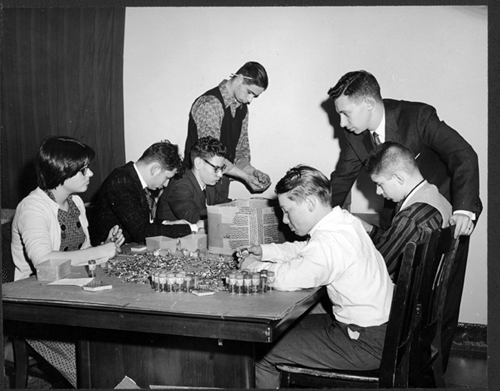
Students with emotional problems in New York City's "600" schools - those schools with the highest dropout rates - are served by a joint program of F•E•G•S, the New York City Board of Education, and the State Division of Vocational Rehabilitation.
1962
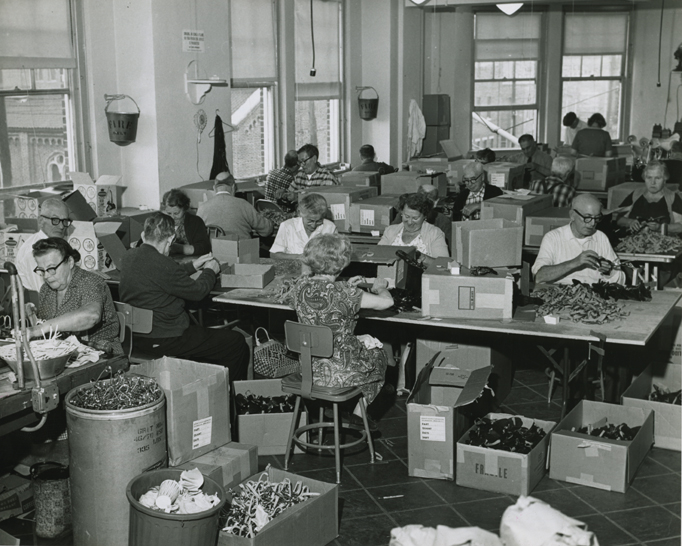
Opens first pilot neighborhood vocational rehabilitation facility in Brooklyn's Coney Island neighborhood.
1964
Project JOIN, a six-agency cooperative demonstration program, helps young people, aged 16 to 18, who are out of school, unemployed, and whose families are long-term welfare recipients.
Begins a cooperative program with the Williamsburg YMHA to serve the vocational needs of the area's Hasidic Jews.
1965
Becomes an official recruitment, counseling and referral service under the Neighborhood Youth Corps.
Opens the first institutional work activities program at Beth Abraham Hospital, as an extension of the F•E•G•S Bronx rehabilitation facility. Similar programs are started at the Daughters of Jacob Home and Hospital and the Jewish Institute of Geriatric Care. More than 240 persons, whose average age is 80, are served annually for almost 17 years.
1966
A staff position is dedicated to the promotion of job opportunities for Sabbath observers.
Operation Rehabilitation Reach-Out services the needs of older, disabled individuals who would benefit from vocational rehabilitation services.
One Hundred Who Left College - a study of the characteristics of college dropouts - is published by F•E•G•S.
1968
F•E•G•S is awarded its first three-year accreditation by the newly-created Commission on Accreditation of Rehabilitation Facilities (CARF).
In cooperation with the Anti-Defamation League of B'nai B'rith, F•E•G•S initiates a program to recruit qualified Jewish individuals for corporate management positions. This program evolved into the Executive Suite program.
1969
In tandem with the American Jewish Committee, the Executive Suite program makes its debut in order to fight discrimination against Jews in corporate management positions.
1970
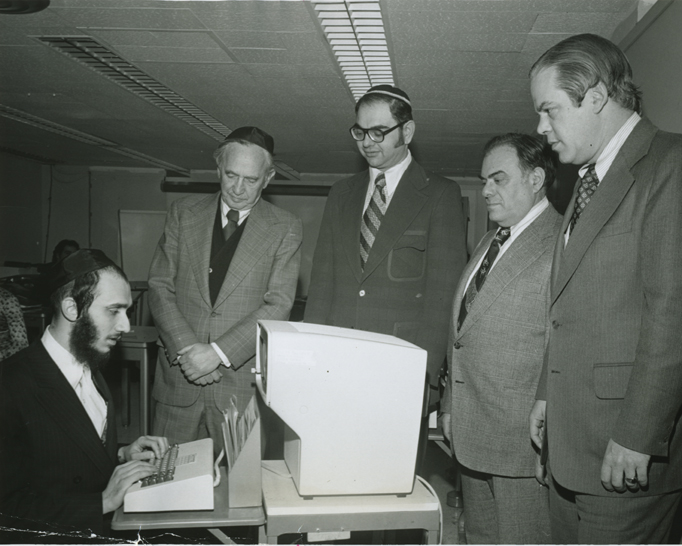
F•E•G•S Trades School begins operation, offering training in a variety of fields, from automotive parts rebuilding to radio/TV repair to air conditioning and refrigeration.
Training programs begin with Con Ed to employ Sabbath observers
1971
Enactment of the Javits-Wagner-O'Day Act expands the opportunities for organizations serving individuals with disabilities to bid on governmental contracts for manufacturing.
In cooperation with the Evening Trades Schools of the New York City Board of Education, F∙E∙G∙S opens the first F∙E∙G∙S Skills Training Center in the Boro Park section of Brooklyn.
White House Conference on Aging gives F∙E∙G∙S a mandate to further develop vocational rehabilitation and employment for the older disabled population.
1973
F•E•G•S receives the first government contract under the Javits-Wagner-O'Day Act for typewriter repairs and automotive parts rebuilding.
The 50 year-old American Rehabilitation Committee merges into F•E•G•S.
1975
The Suffolk Vocational Service Center is established to serve the needs of displaced homemakers and the wider employment needs of the Jewish community.
1976
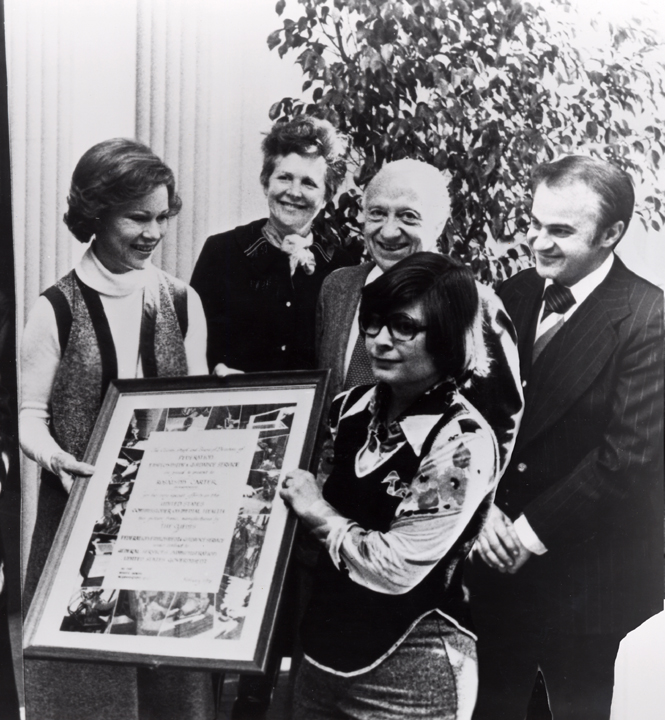
Through the Javits-Wagner-O'Day Act, F•E•G•S manufactures over 740,000 picture frames at its Bronx Rehabilitation Center under a contract from the General Services Administration.
F•E•G•S begins Project ARI (Action for Russian Immigrants) to assist Russian Jewish immigrants who have been in the U.S. for more than one year with job counseling, placement, and other services. In cooperation with the Associated YM-YWHAs and NYANA.
F•E•G•S formulates tests, interviews, and group discussion guidelines to screen candidates for special projects and communities in Israel from among individuals and families considering Aliyah. The project has support from the Government of Israel, The Jewish Agency, and the National Association of Jewish Vocational Services.
F•E•G•S establishes a Synagogue Liaison Program in cooperation with the Commission on Synagogue Relations of the Federation of Jewish Philanthropies.
Alfred P. Miller is appointed Executive Director of F•E•G•S, and will serve as Chief Executive Officer for the next 31 years. Under Mr. Miller's leadership, the agency, which has a $300,000 annual budget, will grow to become a $240 million health and human services system serving 125,000 individuals and families each year.
1978
F•E•G•S creates the CLEAR (Career Ladder to Employment And Rehabilitation) to prepare several hundred severely and profoundly developmentally disabled residents at the Staten Island Developmental Center (formerly Willowbrook) for de-institutionalization and entrance into community residential facilities. The program is one response to the 1975 Willowbrook Consent Decree.
1980
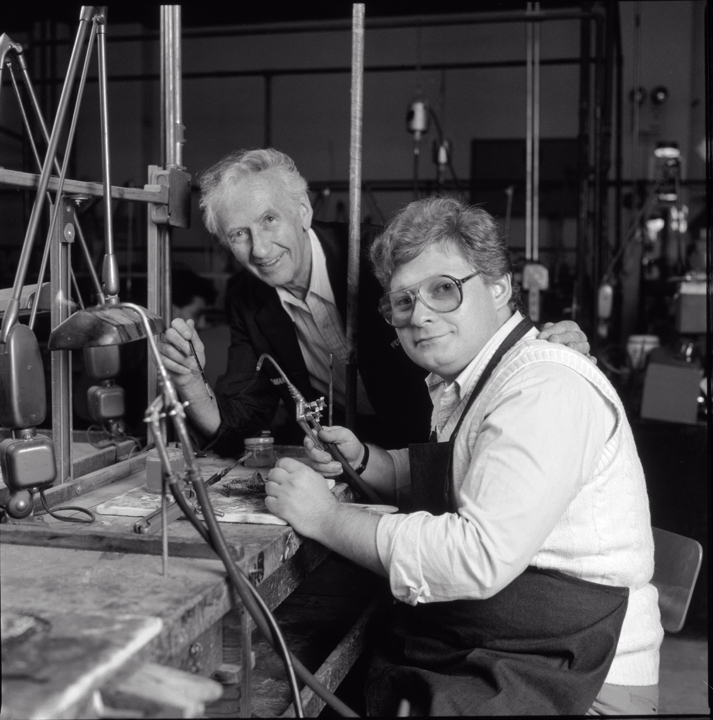
Establishes the Educational Support Services Division to help address the chronic school dropout problems in New York City schools.
Establishes the Jewelry Institute of New York (JINY) as the official training arm of the New York jewelry industry, in cooperation with the Jewelry Institute of New York and the National Association of Jewelry Manufacturers and Silversmiths
1981
F•E•G•S opens three Intermediate Care Facilities in the Bronx to address the special needs of Jewish developmentally disabled individuals in a kosher home setting. The residences are named in honor of two F•E•G•S past Presidents, Richard M. Bleier and Michael Saphier, and a founding Board member, Sarah Sussman.
Establishes the F•E•G•S Educational Services Division
Three TAP (Testing, Assessment & Placement) Centers are used to provide vocational counseling services for hard-to-place residents in New York City neighborhoods with the highest rates of unemployment and poverty. In cooperation with the New York City Department of Employment.
Operation Success begins as a pilot project to identify and counsel "at risk" high school students. It is cited in the Congressional Record of Fall, 1985, as a model dropout prevention program.
Two Developmental Day Treatment Programs are opened to serve individuals with developmental disabilities.
1982
Consultants for Criminal Justice Alternatives (CCIA), an alternative sentencing program begins.
The Mobile Job and Career Centers travel throughout Metropolitan New York to assist individuals with a full range of vocational services.
1983
The Corporate and Career Services initiative assists individuals who have lost their jobs through organizational downsizing.
In a project with the New York City Department for the Aging, F∙E∙G∙S initiates the Senior Employment Service.
Home Attendant Services is established to serve the elderly and medically disabled in their homes.
F∙E∙G∙S expands its for-profit services sector to offset cuts in Federal funding.
1984
New York City Taxi Drivers Institute opens, providing special training for individuals, mostly new immigrants, in language, taxi regulations, dealing with the public, and familiarity with New York City.
The Report on Federation Homeless Project serves to inform the Jewish community about specialized services for the homeless and to provide care and treatment for them. Click here to read an overview of the report.
1985
Opens the Jewelry Technical Training Center of Israel in Hatikvah, Tel Aviv. It is a unique partnership among Israeli jewelry manufacturers, Israeli government officials, the local community, UJA-Federation of New York, and F•E•G•S.
1986
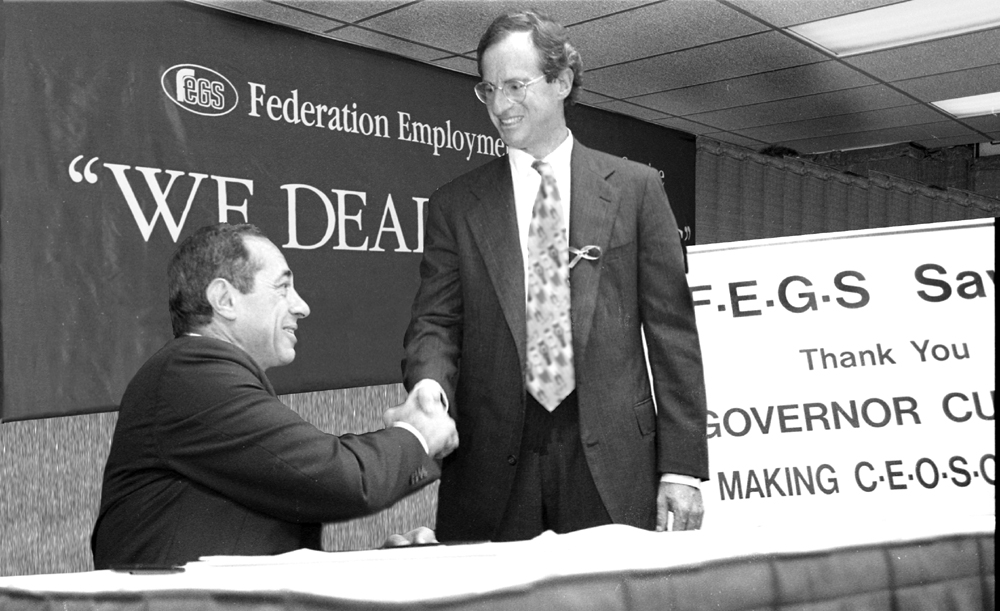
The Comprehensive Employment Opportunity Center (CEOSC) opens as a one-stop employment training center to serve parents on public assistance through an array of job placement, training, child care, and counseling services.
The Challenge Program begins in the Bronx, the only discrete day treatment service for adults with autism.
1987
F•E•G•S completes a $3.1 million Capital Campaign to upgrade infrastructure and enhance internal operating systems.
Inaugurates the Transitional Opportunities Program (TOP) to help adults with developmental disabilities bridge the gap between day treatment and sheltered employment.
1989
New York City Building Services Training Institute is developed.
Partners in Conversation teams volunteers with recent Jewish emigres from the former Soviet Union to help acculturate the newcomers to life in America and New York City.
1990
At the request of UJA-Federation of New York, F•E•G•S assumes and assures the continuity of services and programs to individuals previously served by Altro Health & Rehabilitation Services, which ceases operation.
Opens the Robert Rau Residence in the Bronx to serve adults who are developmentally disabled and who have visual and hearing impairments.
Opens the Judge Caroline K. Simon Supervised Residence for individuals with mental illness.
1991
Opens the 124th Street Residence in Manhattan, providing permanent housing with supportive services to individuals who are homeless and have a mental illness.
1992
UJA-Federation of New York and F•E•G•S create the UJA-Federation Community Trust for individuals with disabilities to help families plan for the long-term needs of relatives.
F•E•G•S is awarded new licenses to establish Intensive Psychiatric Rehabilitation Treatment (IPRT) programs in Manhattan, Brooklyn, and the Bronx.
Inauguration of the Career Assessment Institute, providing advanced training to career development and human resource professionals.
1993
Jewish Community Services of Long Island (JCSLI), a UJA-Federation agency, merges into F•E•G•S, expanding the network of Family Services throughout Queens, Nassau and Suffolk Counties.
NYC Link, in cooperation with the New York City Department of Health and Mental Hygiene, begins to serve incarcerated individuals with mental illness.
1994
Launches Students Advocating Against Violence Initiative (SAAVI) to develop anti-violence programming in Long Island school districts.
Launches youth educational programs for HIV/AIDS on Long Island. Programs grow over the next 15 years to include a wide range of counseling, prevention, financial, and housing services.
1995
Establishes the Collegiate Leadership Internship Program (CLIP) in cooperation with Hillel: The Foundation for Jewish Campus Life. Nine-week paid internships are combined intensive educational seminars on important Jewish community issues
1996
Ten F•E•G•S mental health counseling centers are renamed in honor of Judge Caroline K. Simon, an internationally renowned Judge, New York Secretary of State, philanthropist, and longtime F•E•G•S Board member, past President, and Board Chair.
Establishes two Beacon schools, which provide a range of after-school educational, career preparation, counseling, recreation, and parental support activities.
Creates HR Dynamics, Inc., a diversified human resources consulting company, to provide human resources consulting, project management, and talent/staffing services to F•E•G•S, other nonprofits, government, and business.
1997
At the request of the Suffolk County Division of Mental Hygiene and the N.Y. State Office of Mental Health, F•E•G•S establishes a bi-lingual counseling center in Central Islip, Long Island, in facilities formerly operated by La Union Hispanica.
The Harry and Jeanette Weinberg Mental Health Center in the Bronx opens.
1998
Initiatives are put in place to aid individuals in the transition from welfare to work, starting with the Bronx-based BEGIN (Begin Employment, Gain Independence Now) program. The following year, the Skills Assessment and Job Placement (SAJP) and the Employment Services and Placement (ESP) programs were initiated.
Partners in Citizenship teams volunteers with Jewish emigres from the former Soviet Union, helping the newcomers study and prepare for their citizenship exams. The program helps more than 2,000 Russian emigres become American citizens.
F•E•G•S provides technical assistance to help the Jewish community of Argentina reestablish employment services and create new opportunities in a downsized urban economy
Creates ALLSector Technology Group, Inc., a subsidiary corporation which offers a full range of technical support consulting services, systems integration, voice communications, e-mail, internet, and intranet support.
1999
The Harry and Jeanette Weinberg Health Related and Human Services Center opens, as F•E•G•S creates a state-of-the-art comprehensive service center and administrative headquarters in the Hudson Square area of lower Manhattan.
Inaugurates the Susan R. Knafel Internship Program, named in memory of F•E•G•S's longtime Board member, who had a special respect for the career aspirations of young people and who was dedicated to making sure they had sufficient career training to enable them to succeed.
2000
F•E•G•S launches NoBody's Perfect, a program to address eating disorders in the Jewish community in adolescent girls and young women. Funding from the Hadassah Foundation, UJA-Federation, and N.Y. State Sen. Carl Marcellino.
2001
In the aftermath of the September 11th terrorist attack on the World Trade Center, F∙E∙G∙S provides counseling and employment services to thousands of individuals, as well as providing assistance to businesses directly affected by the disaster. It will eventually serve more than 200,000 people. For its 9/11 initiatives, F∙E∙G∙S is honored with the Behavioral Healthcare Leadership Award/Leadership in Time of Disaster from Eli Lilly and Company and the 2003 Distinguished Program Award from the International Association of Jewish Vocational Services.
Launches Partners in Caring, a joint project with UJA-Federation and Long Island synagogues, to bring educational, counseling and support services directly to congregants
2002
The Harry and Jeanette Weinberg Brooklyn Behavioral Health and Community Rehabilitation Center opens.
2003
Brooklyn Resource Center opens, creating the only comprehensive center in New York City serving the Russian-speaking community, including a licensed mental health clinic and services for employment assistance, computer skills training, language training, and citizenship preparation.
Hempstead Multi-Service Center opens on Long Island, providing a full range of services, including: mental health services; HIV/AIDS prevention and counseling; family violence services for children and adults; case management; employment services, and other support programs.
2004
Launches Partners in Dignity/The Long Island Regional Care Center, to help individuals and families deal with serious, life-limiting, and terminal illness. It is part of The Jewish Healing and Hospice Partnership, an initiative of UJA-Federation.
ParnossahWorks.org begins - a website for unemployed Jewish professionals to search for employment in the privacy of their own homes, while offering employers the opportunity to post job listings. Works in partnership with the synagogue movements to reach the broad Jewish community.
The Haym Salomon Foundation merges into FEGS, creating the Haym Salomon Division of the Arts, which uses the creative arts as a medium for improving the quality of life for older individuals and those with disabilities.
The Bronx Lab School opens. It is a rigorous college preparatory academy designed for 400 students, with specially developed, mandatory after-school and summer curricula. The project is part of the New York City Department of Education's "small school initiative," spearheaded by the Bill and Melinda Gates Foundation, and in cooperation with the Institute for Student Achievement.
2005
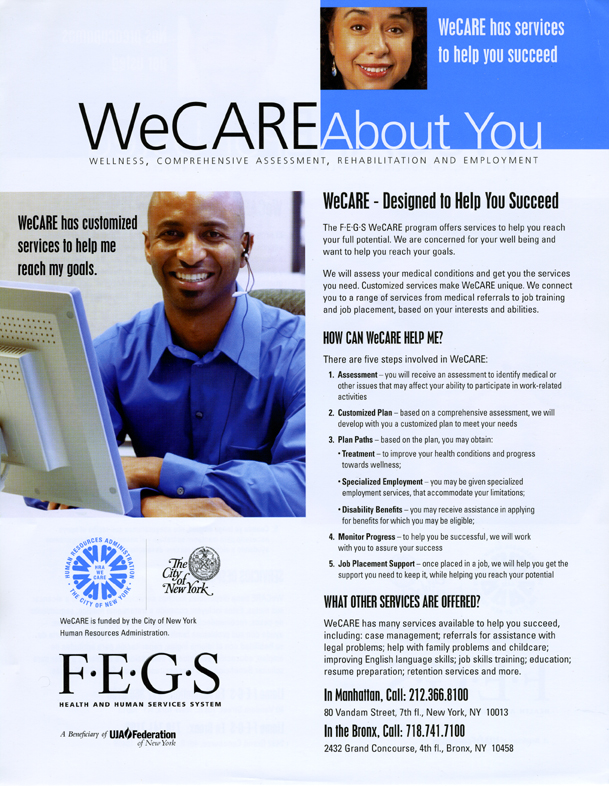
Establishes the WeCare Division. WeCARE (Wellness, Comprehensive Assessment, Rehabilitation and Employment), New York City's major initiative to provide comprehensive medical/wellness/vocational rehabilitation/employment services for public assistance recipients with medical/mental health conditionals will serve over 100,000 participants during its first three years.
2006
The New York Society for the Deaf, a beneficiary of UJA-Federation, merges into F•E•G•S, enhancing F•E•G•S services to the deaf and hard of hearing community.
Launches the Thypin Oltchick Institute for Women's Entrepreneurship @ F•E•G•S to connect women who want to start their own businesses with available community resources.
2007
F∙E∙G∙S and the Israel Anti-Drug Authority, an Israeli government agency, sign a Memorandum of Understanding to cooperate in efforts to reduce drug abuse in the Jewish community.
F•E•G•S and the American Friends of IADA, the Israel Anti-Drug Abuse Foundation, sign a Memorandum of Understanding to cooperate in efforts to reduce substance abuse among Jewish adolescents in Israel and the United States.
Launches Project Independence and Hands on Huntington, two community initiatives based upon the concept of NNORC - Neighborhood Naturally Occurring Retirement Communities. Modeled on an urban design, these programs address the needs of a growing aging population. With input from seniors and local government and community organizations, a broad range of services are coordinated to allow older citizens to remain safe, secure, and independent in their own homes.
Opens the Yatzkan Division of Adolescent Behavioral Health and Substance Abuse, to reduce the incidence of adolescent substance abuse through residential, clinic, rehabilitation, and related services sensitive to the needs of the Jewish community.
F•E•G•S dedicates the Alex and Patricia Gabay Center for Jewish Family Continuity, to strengthen and secure future family services programs on Long Island.
Opens the East Baton Rouge Lab Academy in Louisiana, modeled on the successful Bronx Lab School, where students face a rigorous college preparatory instructional program, taught by a specially dedicated teaching team, and an extended school day and year. In cooperation with the East Baton Rouge Parish School System, the Bill and Melinda Gates Foundation, the Institute for Student Achievement, United Jewish Communities, and UJA-Federation of New York, the initiative is one response to the devastating 2005 Hurricane Katrina.
Opens the Brooklyn Bridge Academy, a transfer high school under the auspices of the New York City Dept. of Education, for overage and under-credited high school students who want to earn their diplomas and work toward post-graduate education. A partnership between F•E•G•S and New Visions for Public Schools.
Begins PROS Possibilities (Personalized Recovery Oriented Services), a New York State-licensed program for adults with a mental illness that combines Continuing Day Treatment, Intensive Psychiatric Rehabilitation Training, and other clinical services in a coordinated program.
F•E•G•S Board of Directors creates the Alfred P. Miller Center for Leadership, Entrepreneurship and Innovation, honoring Mr. Miller's distinguished 40 years at F•E•G•S and his outstanding national and international contributions. The Center brings together leaders from the philanthropic, business, not-for-profit, and public sectors - locally, nationally, and internationally. The Center's mission is to create new models of service delivery; foster trends that marry technology to service delivery and new ventures; create senior executive leadership programs; and consult on global strategic planning that will drive change and innovation in delivering health, education, and human services in the 21st century.
